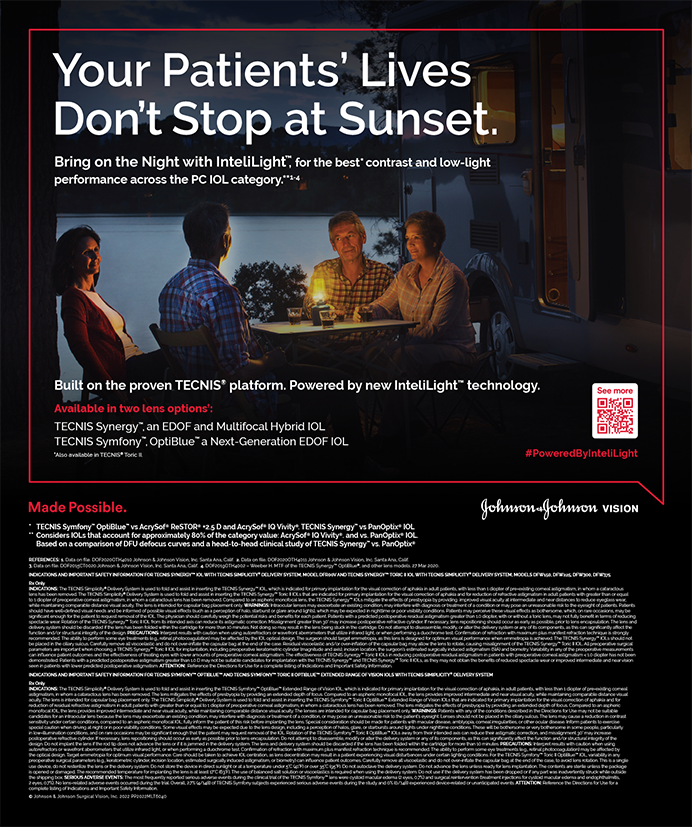Foreward: Cataract surgery on an eye with a history of radial keratotomy (RK) is a complex scenario. Absent surgical records, a variable hyperopic drift, the flattening of the central cornea, and potential lens-induced myopia in this population complicate the process of IOL selection and increase the potential for a refractive surprise after surgery. The Oracle Vision Council, a small and diverse group of millennial ophthalmologists, convened recently to discuss IOL selection in this population. An edited transcript of their discussion follows.
Moderator

F. Beau Swann, MD, MS
Panelists

Zaina Al-Mohtaseb, MD

R. Luke Rebenitsch, MD

Evan D. Schoenberg, MD

O. Bennett Walton IV, MD, MBA

Blake K. Williamson, MD, MPH, MS
SETTING PATIENT EXPECTATIONS
F. Beau Swann, MD, MS: Dr. Rebenitsch, how important is it to set patient expectations in those with a history of RK, and what do you tell them?
R. Luke Rebenitsch, MD: These patients are some of the earliest adopters of vision correction surgery. In my mind, there are two types of post-RK patients: those who want to achieve vision like they had years ago and those who really just want to see better with their glasses. In our practice, we tend to see more of the former.
I usually start by affirming that they chose the best technology available at the time of their surgery but, because of the intricacies of the RK procedure, their cataract surgery journey is going to look different from what their friends have experienced. I typically use a running analogy by sharing with patients that it’s going to be more of a marathon than a sprint. It doesn’t mean that we can’t get good results in these patients, but it’s going to be a different process.
I tell them they are more likely than other cataract surgery patients to need an enhancement or IOL exchange in the future. We also talk about how a trifocal or a bifocal lens may not be the best option for them because of how their cornea is shaped. I certainly underpromise and try to overdeliver, and I emphasize that the process is going to take weeks to months.
Dr. Swann: Dr. Williamson, what expectations do you set in this population?
Blake K. Williamson, MD, MPH, MS: In my experience, post-RK patients really want excellent visual quality and spectacle independence at almost any cost. What makes the preoperative consultation so difficult is that we know these patients will compare their process to what their family and friends who have had cataract surgery have been through. This can create confusion and frustration.
One of the biggest things is letting these patients know from the get-go why their vision won’t be perfect on day 1. I like to start the conversation by explaining that they have scars on their cornea from the RK incisions and that it looks fantastic and the surgeon did a wonderful job with that procedure but that, all these years later, those scars might make it challenging for us to get the most appropriate measurements. We therefore can never guarantee complete and total freedom from glasses, but modern biometry, topography, and tomography help us get pretty close to spectacle independence.
Honestly, if a post-RK patient is doing really well on day 1, that may not be a good thing because we know that the cornea can change over time. Sometimes, it can be 1 to 3 months before the cornea normalizes. These patients should also be aware that it is typical for them to have different refractive errors and different vision throughout the day, no matter what IOL we implant.
Dr. Swann: Dr. Schoenberg, what do you tell your patients about the different technologies that you can offer, specifically laser vision correction versus RK?
Evan D. Schoenberg, MD: Each patient has subtly different expectations and needs, and it is important to read the room, so to speak. When I talk about technology, I try to show patients what I’m looking at. For example, I show patients their own topography and explain to them where the RK incisions are located and the irregular and abnormal areas of the cornea. Then, we talk about what we’re going to do during surgery and their lens options.
THE PREOPERATIVE WORKUP
Dr. Swann: There are so many different technologies one can use during the preoperative examination. Dr. Al-Mohtaseb, in your opinion, what is the absolute minimum amount of equipment you need to get a great result in a post-RK patient?
Zaina Al-Mohtaseb, MD: Technology-wise, the more you have isn’t necessarily always better. Having too many measurements can become overwhelming. At a minimum, it’s important to have at least one topographer and one biometer. In these patients, though, I also like to perform anterior segment OCT (AS-OCT).
Dr. Schoenberg: I like to look at the cornea in multiple ways, and some corneas don’t image as well with Scheimpflug topography as with Placido disc or vice versa, so it is nice to have access to more than one technology. Having different tools available helps guarantee a high-quality image that I can use to better plan the procedure.
Another reason I like having multiple devices is it optimizes clinic flow because you can be working on multiple patients in multiple places at once.
Dr. Swann: Dr. Rebenitsch, do you feel like you can achieve great results in post-RK eyes with just two technologies?
Dr. Rebenitsch: Maybe I’m a typical millennial who loves technology, and maybe I have had more than I need, but I prefer to look at measurements from more devices. I agree that topography and biometry are integral to getting the good results that we love, but I also like to look at epithelial mapping and the posterior cornea.
Motivated patients who are willing to do that full marathon and maybe even undergo a double procedure really can achieve good vision, but again, the preoperative discussion is important. If they’re willing to join me on the journey, I’ll take them.
Dr. Swann: Dr. Mohatseb, why might AS-OCT play a role in the preoperative evaluation?
Dr. Al-Mohtaseb: AS-OCT is an extra data point to plug into the ASCRS calculator. I typically include it for all of my post–refractive surgery patients. I appreciate the work Douglas D. Koch, MD, and Li Wang, MD, PhD, did on this site.
Dr. Williamson: I think that’s a good point. Along those same lines, we all know that central topography is important for planning laser vision correction, but it also plays a role in determining what IOL you’re going to place in patients who had their cornea treated with RK. It can give you relevant information about the flatness or steepness of the cornea, which is helpful.
I also think that true keratometry is helpful when selecting the IOL in post-RK eyes. We’ve just adopted this over the past several months.
Dr. Al-Mohtaseb: It’s nice to have all these technologies, but remember there’s clinic flow and billing. You can’t bill for five topographies and three biometry measurements. Incorporating one or two technologies that provide several data points is really helpful for clinic flow and the whole concept of billing.
O. Bennett Walton IV, MD, MBA: One thing to bear in mind is that some surgeons may not have a topography device or don’t use it often. For them, it can be complicated to learn how to interpret the maps in post-RK eyes. Typically, the color scale is either variable, where it might change from scan to scan with the step sizes and the colors, or it is fixed. At first glance, it might look like RK patients have a beautiful uniformity, but many times it is because the cornea is actually flatter than the fixed scale. Some topography devices incorporate a different set of colors for flat corneas so that you can trust the colors intuitively between variable or fixed scales.
THE CROSSLINKED CORNEA
Dr. Swann: When it comes to CXL, how much benefit is there to locking down the cornea structurally before cataract surgery?
Dr. Rebenitsch: My partner had performed about 10,000 RKs many years ago, and all these patients are coming back for cataract surgery now. A lot of them have diurnal fluctuations. I’ve tried performing CXL on a few. I think it adds some minimal benefit, but the diurnal fluctuations persist.
Dr. Schoenberg: I agree that there’s a role for CXL. I routinely bring it up as part of my preoperative discussion after asking a leading question such as the following: “Is your vision in the morning different than it is in the evening?” If the answer is yes, I try to quantify that difference. I ensure I have a morning refraction and a late afternoon refraction. If there’s substantial variation (ie, > 1.50 D), I consider performing CXL before cataract surgery to reduce the diurnal fluctuation.
As Dr. Rebenitsch said, it’s important you don’t oversell this because it will not fix their diurnal fluctuations. It should, however, bring them into a fluctuation range of 1.00 D or less versus 2.00, 3.00, or even 4.00 D so that we can more accurately select the IOL. It’s an expensive way to get a modest improvement in the cornea. You have to have the right patient who’s motivated and understands it is an off-label use.
Dr. Walton: I have done CXL on a few post-RK eyes, but, in general, I am not sure that CXL provides as much benefit to these patients as other interventions might. In these patients, that narrower range of fluctuation might put them in a hyperopic state more of the time. It also might put stress on the RK incisions.
PREPARING THE EYE FOR CATARACT SURGERY
Dr. Swann: What is the role of topography-guided PRK in post-RK eyes?
Dr. Schoenberg: For motivated patients, topography-guided PRK can be an important tool. Topography-guided PRK is my first priority before IOL selection for RK patients who experience nighttime glare, ghosting, or coma, for instance. Unfortunately, it can be hard to obtain high-quality images in a lot of these RK patients.
Dr. Swann: Dr. Rebenitsch, what are your thoughts on topography-guided PRK?
Dr. Rebenitsch: I couldn’t agree more with what Dr. Schoenberg said. We do a fair amount of topography-guided PRK, so our technicians are adept at getting scans, even in this difficult population, but it is challenging. The preoperative discussion is important because there are times when you may normalize the cornea and the patient becomes more hyperopic or myopic. Patients need to know that this is going to be a long journey, but if they want the best potential quality of vision, performing topography-guided PRK before cataract surgery may be an option in certain patients.
Dr. Walton: Alternatively, sometimes you can do a routine PRK. For patients with a history of four- or eight-cut RK who like their preoperative spectacle vision, sometimes a routine PRK may be fine. Maybe you go the extra mile and do a topography-guided PRK on patients who don’t like the quality of their vision with spectacles. The goal would be better, not perfect, and neither is to the level of precision needed for a post-cataract enhancement.
Dr. Schoenberg: That’s a perfect litmus test and sort of an easier way to elicit a truthful response from patients. Ask them, “How was your vision in your glasses 3 years ago?” If their vision was fine, then a routine PRK is probably good enough.
LENS FORMULAS
Dr. Swann: We’ve talked about preparing patients for post-RK IOL selection. Let’s get into the nuts and bolts of what formulas everyone uses to get these outcomes. For most people, myself included, that is the Barrett True K. Dr. Al-Mohatseb, you still use the ASCRS calculator. Why do you still use this calculator when the Barrett True K formula is available?
Dr. Al-Mohtaseb: The Barrett True K formula is on the ASCRS calculator, so it’s not one versus the other for me. The ASCRS calculator is updated every year, and more formulas are added to it. For those who have a lot of different topographers and biometers, like we do, it is a great way to synthesize the keratometry readings from different devices and enter them into the different formulas.
Some devices measure the total corneal power, which if perfectly accurate would be ideal and would make IOL selection a lot easier. We’re getting more accurate. We’re not there yet, but we’re getting there. And of course not everyone has access to these kinds of devices.
Dr. Rebenitsch: Many times, post-RK patients who have long eyes also have dry eye disease. In these patients, optimizing the corneal surface is crucial. If the preoperative scans do not look good, we ask patients to come back once their dry eye symptoms have improved with treatment. Accurate measurements, including axial length, corneal thickness, and effective lens position, are crucial to achieving the optimal result. The bottom line is that focusing on getting good results in all patients, even challenging ones such as post-RK patients, is going to make them happier and your practice grow.
Dr. Swann: Great point. Dr. Walton, what formulas do you use in post-RK patients?
Dr. Walton: I like the Barrett True K. In our practice, we go to the ASCRS calculator to use this formula because I don’t want our technicians to have to enter diagnostic information differently for laser vision correction patients and cataract surgery patients.
On another note, I have found that post-RK patients do well with the Light Adjustable Lens (RxSight). It’s an easier target to hit because we’re able to adjust at least 2.00 D of sphere and 2.00 D of cylinder.
ASTIGMATISM CORRECTION AND PREMIUM IOLS
Dr. Swann: No one in this group is shy about implanting toric IOLs in post-RK patients with four to eight small cuts, but when would you shy away from using a toric IOL?
Dr. Walton: In my mind, one should not use a toric IOL if there is no cylinder in their refraction and there is no regular astigmatism on the cornea. We historically don’t lean on refraction for toric decisions, but with RK patients, most of the irregularity is on the cornea. In these eyes, I find the refraction to be helpful. And, of course, with the Light Adjustable Lens, I can choose to adjust sphere and cylinder or only sphere.
Dr. Schoenberg: I couldn’t say it better than Dr. Walton did. When it comes to using toric IOLs, I treat RK patients the same as I treat patients with keratoconus. I want to see a central regular pattern of astigmatism, and I want to see it in the refraction. It can be ±1.00 D or ±10º to 15º, but it needs to be in that ballpark for me to consider a toric IOL.
Dr. Al-Mohtaseb: It can be extremely difficult to hit the spherical target in these eyes. If you correct 1.00 to 2.00 D of astigmatism and the patient ends up a 3.00 D hyperope, you’re not doing them any favors.
Treating astigmatism in post-RK eyes is also challenging. In my work with Drs. Koch and Wang, we looked at manifest refraction at 8 weeks after cataract surgery in 40 post-RK eyes with significant astigmatism that received toric IOLs in order to ensure the stability of their refraction (submitted to ASCRS 2021). The magnitude of astigmatism improved from about 2.10 D preoperatively to 0.46 D at 8 weeks. At the 8-week follow-up, about 73% of eyes had less than 0.50 D of astigmatism, which is excellent for RK eyes.
We now follow three basic criteria when deciding whether a toric IOL is appropriate in these patients. The first is the presence of regular bow-tie corneal astigmatism within the central 3-mm optical zone. The second is minimal variability in the magnitude of astigmatism (< 0.75 D) between two measurement devices. The third is minimal variability in the axis of astigmatism (< 15º) between two measurement devices.
Dr. Swann: That is fantastic, Dr. Al-Mohtaseb. It’s important research as we try to automate what we do in these scenarios. Let’s talk about multifocal IOLs. Dr. Williamson, can you share when you would and would not use multifocal IOLs in post-RK eyes?
Dr. Williamson: I don’t consider presbyopia correction in eyes with more than four RK cuts. I have implanted extended depth of focus, trifocal, and enhanced monofocal IOLs in the past, but I tend to prefer a blended vision strategy with the Light Adjustable Lens.
Dr. Rebenitsch: As Drs. Williamson and Walton said, the Light Adjustable Lens is probably an ideal option in these eyes. We try to be as objective as we can. In addition to the number of cuts, we also consider the spherical aberration and the overall higher-order aberrations. The nice thing about a cornea with a lot of higher-order aberrations is the patient should achieve great intermediate and maybe even near vision with a monofocal IOL.
SURGICAL Techniques
Dr. Swann: Dr. Al-Mohtaseb, regarding your surgical technique, is there anything you do differently with RK eyes?
Dr. Al-Mohtaseb: The first consideration is deciding what type of wound you want to make during surgery. I try to go in between the RK cuts if there is space for me to comfortably make my wound. I have a low threshold for making a scleral incision. I used to do a peritomy and then do a scleral tunnel. Now, I make my wound just about 1.0 mm posterior to the limbus through the sclera and the conjunctiva.
The second consideration is how to safely get the lens out, especially if it’s dense, because a lot of people end up waiting to do cataract surgery on these eyes. I like using the miLoop (Carl Zeiss Meditec) in patients with dense lenses because it decreases the amount of energy I need during phacoemulsification.
Dr. Swann: That’s a great transition into the next topic. Should we be using a femtosecond laser for post-RK eyes?
Dr. Walton: There’s an increased possibility for a capsular tag or for the capsulotomy to radialize. Prefragmenting the lens, however, can help with safety when visibility is limited. I am comfortable performing laser cataract surgery on these eyes, but it is up to each surgeon to decide what they are comfortable with. I also use a femtosecond laser for arcuate relaxing incisions, but I seldom use them in RK cases. Further, post-RK corneas don’t do great with arcs.
Dr. Swann: With all of this preplanning, is intraoperative aberrometry important?
Dr. Williamson: It can be, but I would not change my surgical plans unless it tells me something completely different than my preoperative planning. That is pretty rare these days with my team. Intraoperative aberrometry is just another piece of information for me. It works well with four-cut RKs. When you get to eight and above, however, you just can’t get a good intraoperative aberrometry measurement.
Dr. Schoenberg: I’ll deviate a step in each direction for sphere and cylinder and rotationally if intraoperative aberrometry suggests doing so, but I think you also have to take into account what surgery you just performed and your level of experience with intraoperative aberrometry. If you just managed a mild cataract with little energy utilization and very little fluidics, intraoperative aberrometry may be an accurate measure, especially in a cornea with four or eight RK cuts.
On the other hand, if the cataract was dense and surgery was longer than normal—maybe you added more fluid passing through that cornea—the RK cuts are not in their natural state. That’s a situation where I would not trust intraoperative aberrometry because it’s more likely to be measuring an aberrated cornea.
POSTOPERATIVE CONSIDERATIONS
Dr. Swann: What do you do when you miss the mark? I’ve had patients whose UCVA was 20/25 on postoperative day 1, and 3 months later, they experience a 2.00 D refractive surprise. What do you do here?
Dr. Al-Mohtaseb: Post-RK eyes are the most difficult to hit the mark with when compared with all the other corneal pathologies I see. My go-to strategy is an IOL exchange. These corneas are already not as stable as other corneas, so the key is waiting for stability of the cornea before exchanging the IOL. I do a couple of measurements with time in between to make sure that the cornea has stabilized as much as possible.
Dr. Swann: Does anyone use a three-piece IOL in anticipation that you may have to exchange the lens?
Dr. Walton: I do. I like a three-piece monofocal IOL in general because it is relatively easy to dial out of the capsular bag.
I’m comfortable doing LASIK on an eye that underwent four-cut RK, but I don’t like to do it. I don’t feel like the results are as good as I would want. I don’t love PRK after RK, whether topography-guided or not, because the epithelium is irregular in these eyes and I can’t predict how it’s going to regrow. For all these reasons, I like to stay with the lens. If I feel like I can get patients a result that hits their refraction, then I’ll do an IOL exchange.
Dr. Swann: I couldn’t agree with you more. Dr. Rebenitsch, as a refractive surgery specialist, do you prefer PRK and LASIK?
Dr. Rebenitsch: I will consider an IOL exchange in certain cases, but LASIK or PRK is preferable for me. PRK is not perfect, but I can get the same results treating on the cornea rather than going back inside the eye, which I believe is a lower overall risk to patients.
Dr. Schoenberg: There’s not a one-size-fits-all procedure for post-RK eyes, but I would lean toward an IOL exchange in most cases. If I happen to get a hyperopic result, however, I prefer a piggyback IOL. I use an acrylic lens implanted in the capsular bag during the original surgery, which provides the option of a three-piece silicone IOL in the sulcus treating approximately +0.83 D of correction per 1.00 D of piggyback IOL power.
Dr. Williamson: I like a silicone three-piece IOL simply because it’s aberration-free from the center to the edge. This is beneficial in post-RK patients because each eye has a different spherical aberration profile. I like being right at zero with my lens choice.
I also wait 1 to 3 months after cataract surgery before I consider removing the IOL. This may no longer be an issue now that I am using the Light Adjustable Lens in more of these cases.
Lastly, having a connection with a really good scleral lens fitter is helpful. Sometimes, patients will have a good refraction in the morning but not in the afternoon. We all have tough cases like this, especially when RK involved eight or more incisions. Oftentimes, wearing a contact lens at certain times of day gives these patients their best quality of vision.




